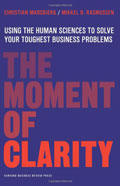 The argument behind this interesting book is that businesses make decisions based on assumptions which often are wrong.
The argument behind this interesting book is that businesses make decisions based on assumptions which often are wrong.
What are those assumptions? Well they come from traditional problem-solving methods taught in business schools (we all use them on a daily basis). The authors sum them up as “Tomorrow Will Look like Today“, “Numbers are the Only Truth“, “Language needs to be dehumanising“, and then show why such “insights” are no longer helpful.
As they make clear in the opening chapter (“Is Yoga a Sport?”) trying to fit certain phenomenon in the existing pigeonholes means a company can miss what is important and what is changing in their environment.
Default thinking might work for everyday challenges, but in the new era of hyper-competition and situations which are – to use the US military term – VUCA (Volatile, Uncertain, Complex and Ambiguous) more sensitive methods are needed – enter the human sciences – anthropology, sociology, philosophy, and psychology.
As the authors put it: “The human sciences address the reality of people’s lives at their most complex and, quite frankly most interesting. Once you start truly understanding people’s behaviour, you will begin to see your business landscape with new clarity.”
If this all sounds a little woolly, the approach certainly isn’t, and in fact the authors parody the “creative workshop” – the sort of thing you see satirised in television programmes such as W1A.
As they point out, brainstorming sessions rest on a number of false assumptions (“Creativity is strange”, “Ideas come out of the blue”, “Creativity is playful and fun”) which are dubious at best, and also fail to help executives “…understand why a series of product launches failed, say, or what is to be done when an entire business is haemorrhaging money quarter after quarter, or how to understand and then bet on the future”.
In explaining the value of the human sciences, the authors do a great job in encouraging executives to use sense-making as a framework. In practice, this means:
- Frame the problem
- Collect the data
- Look for patterns
- Create the key insights
- Build the business impact
When described in that way, the process becomes understandable, while still describing much that is new to most companies.
They do more than this, however. They suggest a practical framework of sense-making; a nonlinear problem-solving approach, and give examples of where it has worked. The case study of Lego (Chapter Five: “The Turnaround“) is worth the price of the book alone (you can read a short sample here, but there are also insights from everyone from Intel and Adidas to Samsung and Coloplast.
The idea is that through these methods, executives get to the point of “the moment of clarity”.
A very interesting read, and certainly worth considering as your next business book buy.
Harvard Business Review Press, £18.99








